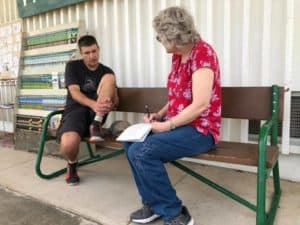
Recently while perusing Facebook—procrastinating instead of writing—I came across a reader’s query regarding Amish fiction. How realistic is it, she asked? Does it accurately reflect how the Amish really live? It’s a great question and one I’m sure many readers ask themselves. It’s also one I’ve longed to answer for myself as the author of fifteen published Amish romances and seven novellas (with more in the pipeline).
First let me say that while I can’t speak for other authors of Amish fiction, I can tell you the ones I know are meticulous about their research. Several have friends in Amish communities. They go to them with questions when they’re not sure about a particular detail or subject matter.
I don’t have a relationship with an Amish person, but here’s what I do when I’m writing my stories. I visit each of the communities where my books are set. That has included Jamesport, Missouri, Bee County, Texas, and the three communities in northwestern Montana, to include Libby, St. Ignatius, and West Kootenai. Seeing firsthand the settings is so critical to details about how the individual districts dress, what their buggies look like, their schools, do they have phone shacks, and so much more. The districts in Jamesport are much more picturesque than the more rustic ones you’ll find near Beeville.
I do my research and then I let my imagination run wild. That’s what writers do. I work hard to be respectful of a value system very different from that of the world. Would an Amish person say that? Would he even think it? That means talking in sweeping generalizations, of course, because every Amish district is different. The Amish do not have a centralized church structure. Each district has its own Ordnung or set of rules. Those rules can be amended by a vote of the church members. This includes everything from their clothes, the style of their prayer coverings, to phones and computers in their businesses. Sometimes readers will say an Amish person wouldn’t do such-and-such because that’s what they’ve seen in communities near them. The fact is the Amish community down the road could very well do whatever it is differently.
To that end, my most valued resource is The Amish by noted researcher and writer Donald Kraybill and his associates. The book covers every aspect of the Amish faith, the rituals they use for church services, the drawing of lots for church leaders, baptisms, funerals, and weddings. Schooling, social events, family dynamics, rumspringa, punishment for violating rules like kneeling confessions and shunning. Kraybill gives the spectrum from conservative to progressive Amish and how their practices differ. It’s a goldmine of information for a writer. I’m able to draw my scenes using accurate details in all of the above areas of Amish life. Details are what give the fictive world its air of authenticity. And it’s important to me to get them right.

I also draw many of my scenes from incidents described by Amish scribes in The Budget Newspaper, which includes blurbs from hundreds of reporters across the country. My story ideas often come from these reports because they contain beautiful portraits of how the Amish live on a day-to-day basis. The way they farm and the accidents that befall them in an agrarian life involving horses, buggies, and equipment no longer used in the modern world.
For regular timely reports on what’s going on in Amish communities I love keeping up with the Amish America blog manned by Erik Wesner. He was a door-to-door book salesman for many years and is welcomed into Amish communities for visits and to many of their important social events. He keeps track of news reports on issues as they come up from buggy reflectors to pitted roads from horseshoes, to manure bags to keep horse poop off the road to Christmas programs. (https://amishamerica.com/about/)
That said, it’s still fiction. My Montana series Amish of Big Sky Country is a case in point. I read about the wildfires affecting Amish communities in the far reaches of northwest Montana and started researching media reports. Some of the Budget scribes wrote graphic accounts of the evacuations and reported on the community efforts—both English and Amish—to rebuild. There’s so much natural tension in simple folks fighting back from a raging wildfire that has decimated their land. So my husband and I spent a week driving around Montana researching the three communities affected in that area. Each is strikingly different.

I found a Youtube video in which an Amish couple who lost their home was interviewed. The husband’s beautiful explanation of how he rejoiced for those who didn’t lose their homes and how they came together to rebuild as a community became the cornerstone of this series, and particularly the first book Mountains of Grace. I interviewed a smoke jumper, visited the smoke jumping training facility, and interviewed the sheriff who oversaw the evacuations in these communities.
In St. Ignatius, we learned that the district (and the town) is on the Flathead Indian Reservation. We visited the Mission General Store, owned by an Amish family, and drove by their school and homes and saw an elderly Amish man riding his bicycle along the road. Tim and I visited the People’s Center in Pablo and learned about the history of the Kootenai Indians who occupied this land long before explorers touched it. All was fodder for The Long Bridge Home, which releases Feb. 11, 2020.
In Libby I was able to talk to a member of the evangelical district who confirmed what I read about their take on being Amish but embracing a very different style of worship and set of beliefs than their counterparts. There are also videos on Youtube of a Libby church service that is charismatic and totally uncharacteristic of the Amish. This research became the basis for Peace in the Valley, the last book in the Amish of Big Sky Country series (it will debut in August 2020).

While in Libby the young man to whom we spoke introduced us to some family members who were visiting from Indiana. They were traditional conservative Amish who’d ridden the train for two days to visit this region. They had as many questions for me as I did for them. The women wanted to know where the writers came up with their ideas for the stories. Which meant they were reading them. One asked me if I’d brought any of my books because it was a long ride back on the train. Unfortunately, because I flew, I hadn’t stuffed any books in my suitcase. They seemed fine with the stories, although one woman suggested they could be a little far fetched.
Bottom line? All novels are fiction. They come from the overactive imaginations of creative writers. We ask ourselves what if this happened? What if these two people met in the middle of the worst day of their lives? Would they fall in love? They might. Would it last? It might.
My goal is to tell an entertaining story that makes the reader think even after she’s reached the end of the story while being respectful and honoring the beliefs of the Amish.
Writing Amish fiction has been a joy. I hope to continue to do it for many years. It’s also my hope that readers will receive joy, hope, and food for thought in every book. If you have questions or comments about Amish fiction and my research methods, please leave them in the comments and I’ll be sure to respond!

